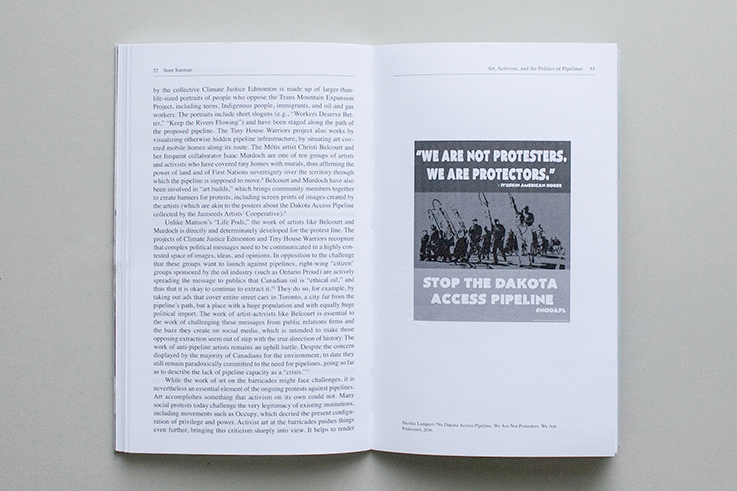Press information
Oliver Ressler (Ed.): Barricading the Ice Sheets. Artists and Climate Action in the Age of Irreversible Decision
Infos
Ed. by Oliver Ressler.
Accompanying the conference “Barricading the Ice Sheets,” Camera Austria, 28. / 29.2.2020.
With contributions by Maja and Reuben Fowkes, Lenka Kukurová, Oliver Ressler, Vanina Saracino, Imre Szeman (eng./ger.).
Edition Camera Austria, Graz 2020.
88 pages, 13 × 21 cm, numerous b/w illustrations.
€ 14.90 / ISBN 978-3-902911-54-4
“Barricading the Ice Sheets” is a research endeavor by Oliver Ressler and supported by the Austrian Science Fund (FWF: AR 526).
Press downloads

Press Information
Artists’ involvement in social movements has developed significantly over the last few years. Not so long ago, artists mainly contributed to the movements’ visual identity, creating banners, posters, websites, and so on. Today, however, artists and cultural producers increasingly tend to become central protagonists, whether as spokespeople or in shaping media tactics and broader strategy. The four essays collected in this book confront the reality of the climate crisis without either illusion or resignation, discussing the possible contribution of artistic work with an acute awareness of the difficulties involved.
Excerpt from the foreword: Oliver Ressler, “Artists and Climate Action in the Age of Irreversible Decision”
Many people today see a change in personal behavior as a solution to the climate crisis. It is important to take a train instead of a plane, eat vegetables instead of meat, or put solar panels on a residential roof instead of burning gas. But private gestures of good faith alone are not equipped to stop epochal climate vandalism on a planetary scale. Planetary life is more than consumer behavior. Our power and responsibility as inhabitants of the Earth are collective and social, not private and personal. Powerful structures, not personal decisions, force us into lives that destroy livelihoods, devalue life, and ultimately endanger survival. We who suffer from those structures are collectively implicated in them, which is why they must be changed by our collective action or not at all. As Lenka Kukurová writes in her essay “Dancing on the Ruins”: “Individual and systemic change must be combined, and the latter should be the focus of energy” (p. 29).
Today, the climate movement is stronger than ever. Polite symbolic protest is a distant memory. In the last couple of years, the movement has materially obstructed “flagship” fossil-furnace projects all over the world. Arctic drilling, the Keystone XL tar sands pipeline, and shale frackers were stopped in their tracks by collective action. Some of Europe’s filthiest coalfired power plants were shut down by non-violent sabotage. Institutional investors began unloading fossil-fuel stocks in an act of tacit surrender to relentless climate movement pressure. More recently, Extinction Rebellion brought business as usual in London to a standstill for days at a time with blockades of bridges, successfully pressuring the British parliament to declare a “climate and environment emergency”—the first such proclamation by any European state. Such actions have immediate, concrete impact at the local site; and thanks to new means of communication, their “virtual” impact is felt across the planet. In his reflection on “Art, Activism, and the Politics of Pipelines,” Imre Szeman observes that the “existence of virtual worlds means that demonstrations today need to be designed to generate traffic on the web as much as to block traffic in the streets” (p. 49).
It should come as no surprise, then, that even the Bank of England— whose mandate does not include handing out stock-picking tips—has warned that hydrocarbons and traditional power plants will soon be doomed investments. But the “carbon bubble”¹ that troubles the central bankers and their peers is just one sign of the coming upheaval, and far from their only reason to fear it.
As writers here and elsewhere argue, art and culture can play a decisive role in confronting climate crisis by opening up new perspectives, inventing surprising ways to visualize and understand reality, by provoking debate, or, as Vanina Saracino formulates it here, by calling forth “machines of deceleration” that oppose “acceleration as the predominant temporality of growth and progress in technocapitalism” (p. 39). All of this is true for sure.
But another aspect has yet to receive the attention it merits. Namely, the role of artists and cultural producers in the climate movements as participants and direct agents of change. Artists’ involvement in these movements has developed significantly over the last few years. Not so long ago, artists mainly contributed to the movements’ visual identity, creating banners, posters, websites, and so on. Today, however, artists and cultural producers increasingly tend to become central protagonists, whether as spokespeople or in shaping media tactics and broader strategy. Nato Thompson has called this the “creative and productive unity of art and activism”;² Maja and Reuben Fowkes observe in this volume that “it is becoming harder to separate out the artistic component of social protest, as movements spontaneously develop tactics that appear to be inspired by artistic strategies and artists are fully immersed in collective struggles” (p. 19).
¹ Damian Carrington, “Bank of England warns of huge financial risk from fossil fuel investments,” The Guardian, March 3, 2015, https://www.theguardian.com/environment/ 2015/mar/03/bank-of-england-warns-of-financial-risk-from-fossil-fuel-investments.
² Nato Thompson, Seeing Power: Art and Activism in the Twenty-First Century (Brooklyn NY, and London: Melville House, 2015), p. 25.
Images
Publication is permitted exclusively in the context of announcements and reviews related to the exhibition and publication. Please avoid any cropping of the images. Credits to be downloaded from the corresponding link.







